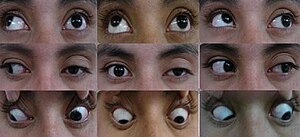Ophthalmoplegia
| Ophthalmoparesis | |
|---|---|
 |
|
|
Neuro-ophthalmologic examination showing ophthalmoplegia affecting the left eye in a patient with Tolosa-Hunt syndrome. The central image represents forward gaze, and each image around it represents gaze in that direction (for example, in the upper left image, the patient looks up and right; the left eye is unable to accomplish this movement). The examination shows ptosis of the left eyelid, exotropia (outward deviation) of the primary look of the left eye, and paresis (weakness) of the third (oculomotor), fourth (trochlear) and sixth (abducens) left cranial nerves.
|
|
| Classification and external resources | |
| Specialty | ophthalmology |
| ICD-10 | H49.3-H49.4 |
| ICD-9-CM | 367.52, 376.22, 378.55, 378.56, 378.72, 378.86, 378.9 |
| DiseasesDB | 9240 |
| MeSH | D009886 |
Ophthalmoparesis or ophthalmoplegia refers to weakness (-paresis) or paralysis (-plegia) of one or more extraocular muscles which are responsible for eye movements. It is a physical finding in certain neurologic, ophthalmologic, and endocrine disease.
Ophthalmoparesis can involve any or all of the extraocular muscles, which include the superior recti, inferior recti, medial recti, lateral recti, inferior oblique and superior oblique muscles.
It can also be classified by the directions of affected movements, e.g. "vertical ophthalmoparesis".
Ophthalmoparesis can result from disorders of various parts of the eye and nervous system:
Thiamine deficiency can cause ophthalmoparesis in susceptible persons; this is part of the syndrome called Wernicke encephalopathy. The causal pathway by which this occurs is unknown. Intoxication with certain substances, such as phenytoin, can also cause ophthalmoparesis.
Treatment and prognosis depend on the underlying condition. For example, in thiamine deficiency, treatment would be the immediate administration of vitamin B1.
...
Wikipedia
